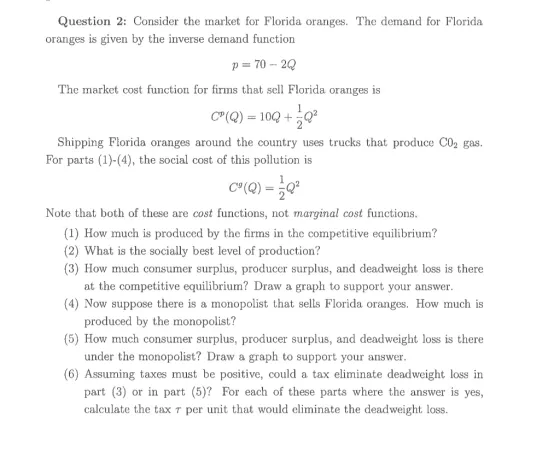Question 2: Consider the market for Florida oranges. The demand for Florida oranges is given by the inverse demand function p = 70-2Q The

Question 2: Consider the market for Florida oranges. The demand for Florida oranges is given by the inverse demand function p = 70-2Q The market cost function for firms that sell Florida oranges is C(Q) = 10Q+Q Shipping Florida oranges around the country uses trucks that produce CO gas. For parts (1)-(4), the social cost of this pollution is C(Q) = 19 Note that both of these are cost functions, not marginal cost functions. (1) How much is produced by the firms in the competitive equilibrium? (2) What is the socially best level of production? (3) How much consumer surplus, producer surplus, and deadweight loss is there at the competitive equilibrium? Draw a graph to support your answer. (4) Now suppose there is a monopolist that sells Florida oranges. How much is produced by the monopolist? (5) How much consumer surplus, producer surplus, and deadweight loss is there under the monopolist? Draw a graph to support your answer. (6) Assuming taxes must be positive, could a tax eliminate deadweight loss in part (3) or in part (5)? For each of these parts where the answer is yes, calculate the tax r per unit that would eliminate the deadweight loss.
Step by Step Solution
3.34 Rating (160 Votes )
There are 3 Steps involved in it
Step: 1
To solve this problem we need to find the competitive equilibrium the socially optimal level of prod...
See step-by-step solutions with expert insights and AI powered tools for academic success
Step: 2

Step: 3

Ace Your Homework with AI
Get the answers you need in no time with our AI-driven, step-by-step assistance
Get Started


